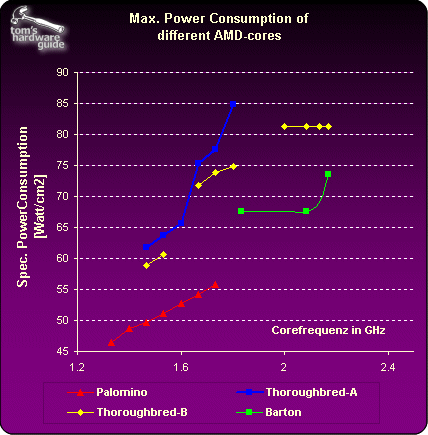How Good Are AMD's Bundled Coolers For The Athlon XP ?
AMD Bundled Coolers: Blessing Or Curse? Continued
Now let's look at the (boiled-down) equation that describes the cooling capacity/ heat conduction provided by a cooler:
Iw = G*(TD -TA ) whereas G=* (A/l)
where
Iw : Heat flux (thermal power of the processor)
G: Thermal conductivity coefficient of the cooler
?: Thermal conductivity of the cooler material
A: Surface through which heat flows (contact surface between die and cooler)
l: Path taken by heat flux
TD : Maximum acceptable die temperature according to specifications
TA : Temperature of the air surrounding the fan
According to the equation, the greater the contact surface between the cooler and the die, the greater the heat flux. It also indicates a proportional relationship between the heat flux, Iw, and the contact surface, A. To get back to our Athlon XP 3000+ and the 2700+, the equation tells us that CPUs with Barton cores are "easier" to cool because the die surface is twenty percent greater, while their maximum thermal power is a mere ten percent higher.
So any cooler suitable for the Athlon XP 2700+ shouldn't have any problems cooling a Barton CPU like the 3000+. In fact, the advantage gained by the larger die surface won't be cancelled out until you reach maximum thermal-power levels exceeding 82 watts.
Get Tom's Hardware's best news and in-depth reviews, straight to your inbox.
Specific thermal power of different AMD cores.
Current page: AMD Bundled Coolers: Blessing Or Curse? Continued
Prev Page AMD Bundled Coolers: Blessing Or Curse? Next Page Measuring Like AMD: Temperature Sensors Right On The Die